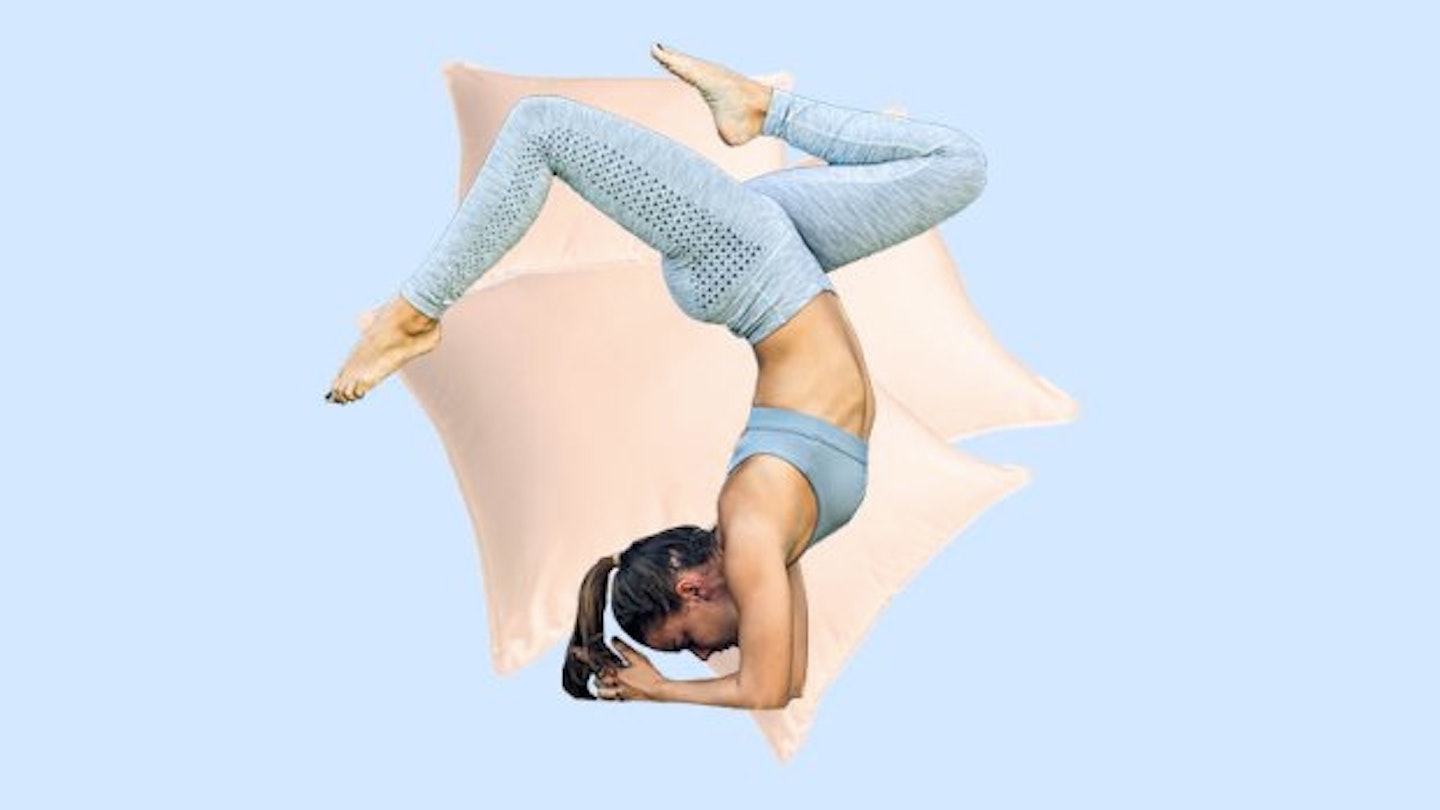Is anyone else super fascinated by other people’s night time routines? Perhaps my curiosity stems from a long old struggle with poor sleep and wanting to do it better, but there’s just something about the habits that those super-efficient/organised/well-rested people swear by that really peaks by inefficient/unorganised/over-tired interest.
For a long time now, exercise has been recommended as a remedy for sleepless nights. And while the idea of spiking your adrenaline and working up a sweat might initially seem counter-productive to the whole rest thing, yoga practice could be the bit that’s missing from your bedtime ritual to easy you into the slumber of your dreams.
‘The reason why yoga is great in the evening is that it works on a number of levels,’ says Louisa Hollway, a private yoga instructor in London. ‘There are a number of physical benefits – the exercise element tires your body out, which makes it easier for you to fall asleep; the stretching can release areas of tension you may be holding; and the focus on regulating and elongating your breath calms your body down, and essentially tells your brain to relax.’
The link between insomnia and anxiety is probably pretty familiar to many of us, and what makes yoga so attractive as a pre-bed activity is the practice of conscious breathing and physical distraction – which isn’t too far from the wider more general recommendations to help ease an anxious mind. ‘There are even a number of sleep aid exercises where you are encouraged to breathe in such a way as to mimic the way you breathe when asleep’, Louisa explains. ‘This can be practised in a number of ways in yoga, for example, Nadi shodhan, which is alternate nostril breathing, which is also a great way to centre your mind.’
WATCH: Relieving Stress With Maya Fiennes
Now, if you’re not a seasoned yogi you’re probably thinking ‘what on earth is relaxing about trying to twist yourself into a wobbly eagle while one calf is still cramping from your surprisingly challenging warrior two? Well, the key is choosing the right type of yoga. ‘Although a really fast-paced vinyasa class with loads of chest openers might not be the most relaxing thing, a more restorative practice or a focus on hip openers can really work your body and get it ready to relax and calm down.’ Louisa says. If you’re thinking about attending an evening class to help you unwind, you want to do a restorative or ‘yin’ (as in, the opposite of yang) class. Yin is more of an introspective type of class. Lousia tells me that it works on the fascia which is the deep tissue of the body and involves holding poses for a bit longer than you’d be used to. ‘It’s great for opening up the hips, although you may experience some emotional release during these classes, which I think can only be a good thing! The more tension we are carrying around, the harder it is for our body to know to let go.’
In terms of timing, Louisa recommends either doing them early on in the evening before a light dinner or literally just before bed: ‘but you want to be sure to leave out any backbends if you’re going for the latter’, she explains. If you’re a YouTube yoga kinda person, the 40-minute bedtime yoga sequence by Yoga with Adriene comes highly recommended by Louisa, as does Ali Kamenova’s moon flow. But if you just want a few poses that you can try in your own time, Louisa’s given us three great ones to try.
1. Modified bridge roll
‘Lie semi-supine, feet hip distance apart. Make sure you can skim your heels with your fingertips and your hips and knees are in one line. Place your hands flat on the floor and as you inhale, press down with the feet, engage your legs and roll up through the spine. As you exhale raise your arms over your head, and then as you inhale, place your arms back down by your sides. Exhale and slowly drop one vertebra after the other down onto your mat. Repeat x 4 (or more!)’
2. Wind releasing pose into semi-supine twist
‘Lie down on the ground, making sure your shoulders are not hunched up and there is no tension in the face (you should always ask yourself this in any pose). Inhale your right knee into your chest and interlace your hands around your shin. Exhale, and roll your shoulder blades down your spine as you pull the knee closer towards you. It can be nice to do some hip circles here.
‘Keep inhaling and pulling the knee towards you, and exhale and roll your shoulder blades down your spine, keeping your spine on the floor. It can be nice to take one inhale and see if you can touch your forehead or chin to your knee – keeping your shoulders down.
‘Then, drop your right knee over to the right and stretch your left arm away from you. If you can’t get both the shoulder and the knee on the ground, take a cushion and put it under your right knee. As you inhale, feel that you are stretching up through the spine, and as you exhale, twist. Hold this for 5-10 breaths. To release, roll back onto your back, pull the knee in and switch legs.’
3. Baddha konasana or bound angle pose – restorative version
‘Lying on your back, bring the soles of your feet to touch. Bring your feet closer to your perineum (groin) if you want to intensify, farther away if want a gentle hip opener. You can also place cushions or bolsters under your knees if you want a bit more of a restorative version.’ ** **
Like this? You might also be interested in…
Follow Jazmin on Instagram @JazKopotsha
This article originally appeared on The Debrief.
